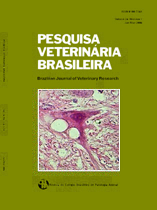 |
|
|
|
Year 2012 - Volume 32, Number 12
|

|
Pyrethroid toxicity in silver catfish, Rhamdia quelen, 32(12):1297-1303
|
ABSTRACT.- Montanha F.P., Galeb L.A.G., Mikos J.D., Ganeco L.N., Pereira T.P., Tanaka A., Kirschnik P.G. & Pimpão C.T. 2012. Pyrethroid toxicity in silver catfish, Rhamdia quelen. Pesquisa Veterinária Brasileira 32(12):1297-1303. Laboratório de Pesquisa e Piscicultura, Pontifícia Universidade Católica do Paraná, Rodovia BR 376 Km 14, Bairro Costeira, São José dos Pinhais, PR 83010-500, Brazil. E-mail: chicopm28@yahoo.com.br
This study aimed to determine both the lethal and sublethal concentrations of Cypermethrin in young Silver Catfish (Brazilian “Jundiá”, Rhamdia quelen) on aquatic environment during 96 hours, as well as to determine the Cypermethrin and Deltamethrin sublethal concentrations during the initial embryonic development period of Rhamdia quelen, and to verify their respective rates of fertilization, hatching and survival. Pyrethroid nowadays is a widely used insecticide, which presents a high toxicity to fish. In order to determine lethal and sublethal concentrations, 120 silver catfish were used; each one had an average weight of 59.58±4.50g and an average size of 20.33±2.34cm. Concentrations used were 0, 1.0, 1.5, 2.0, 2.5, 3.0, 5.0, 10.0, 15.0 and 20.0mg of Cypermethrin per liter of water (mg/L). Fish were exposed to the product in 30-liter fish tanks. In each fish tank there were four fishes and the product was applied three times, i.e., a total of twelve fish were exposed to the product at each application, and a total of 120 fish during the entire experiment (n=120). In order to determine the Cypermethrin and Deltamethrin sublethal concentrations during the initial embryonic development, ovulation induction was performed on female fishes using hormones, and then and egg collection was performed. The eggs were then hydrated and fertilized in Cypermethrin and Deltamethrin in different concentrations: 0.001, 0.01, 0.1, 1.0 and 10.0mg/L of Cypermethrin and 0.001, 0.01, 0.1, 0.5 and 1.0mg/L of Deltamethrin, in addition to the control group (0mg/L). After fertilization, the eggs were kept in containers with the respective pesticides of Cypermethrin and Deltamethrin until hatching, when hatching rate was verified. Then the alevins, from the hatching, were kept on their respective concentrations of Cypermethrin and Deltamethrin so that the survival rate could be analyzed regarding the tested insecticides, during both 12-hour and 24-hour periods. Concerning the sublethal and lethal concentrations, Silver Catfish was sensitive to the tested concentrations of Cypermethrin, showing symptoms of poisoning, such as loss of balance, swimming alteration, dyspnea (they kept their mouths and opercula open), upright swimming and sudden spiral swimming movements. The intensity of such symptoms varied in proportion to the concentration used. The concentrations above 3.0mg/L were considered lethal to the species, since every animal exposed to concentrations between 3.0 and 20.0mg/L had died, while concentrations between 1.0 and 2.5mg/L were considered sublethal. Lethal concentration of Cypermethrin to Silver catfish, in 96 hours, was 1.71 milligram per liter of water. Concerning the sublethal concentration of Cypermethrin and Deltamethrin during the initial embryonic development, the results show that both pyrethroids had significantly decreased the analyzed parameters when comparing them with the control group. It was concluded that, even with the fish being more resistant to pyrethroids in comparison with other species, both the young animals and the ones in stage of embryonic development were susceptible to the effects of these pesticides. |
| |
|
|
| |
|
 |